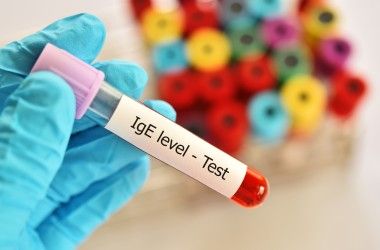General Health
IgE Test – Normal Range, Purpose, Procedure, and Results Interpretation
5 min read
By Apollo 24|7, Published on - 16 May 2025
Share this article
0
0 like

The immune system plays a vital role in defending the body against harmful substances. However, sometimes it overreacts to harmless elements like pollen, pet dander, or certain foods. These overreactions are known as allergic responses, and Immunoglobulin E (IgE) is at the heart of this immune response. An IgE test helps detect allergies by measuring the level of IgE antibodies in your blood. Understanding what an IgE test is, why it’s needed, and what the results mean can empower patients to make informed decisions about their health.
Whether you are experiencing unexplained allergic reactions, asthma symptoms, or skin rashes, an IgE test can provide crucial insights into the cause. This article provides an in-depth look into the IgE test, covering its purpose, how it’s done, normal and abnormal ranges, and what the results mean for your health.
Purpose of the IgE Test
The IgE test is primarily used to detect allergies and evaluate immune system responses. When your body encounters an allergen, such as dust, pollen, or certain foods, it may produce IgE antibodies. These antibodies attach to cells and release chemicals like histamine, triggering allergic symptoms.
Common reasons a doctor may recommend an IgE test include:
- Recurring skin rashes or eczema
- Frequent sneezing, nasal congestion, or a runny nose
- Asthma symptoms that flare up unexpectedly
- Chronic sinus infections
- Food sensitivities or suspected food allergies
- Anaphylaxis or other severe allergic reactions
There are two main types of IgE tests:
- Total IgE Test: Measures the overall level of IgE antibodies in your blood.
- Specific IgE Test: Identifies IgE antibodies to particular allergens (e.g., peanuts, mould, dust mites).
Understanding your IgE levels can help your healthcare provider determine whether your symptoms are allergy-related and guide further testing or treatment.
How to Prepare for an IgE Test?
One of the advantages of the IgE test is that it typically requires little to no preparation. However, here are some general tips to ensure accurate results:
- Medication Disclosure: Inform your doctor about any medications you’re taking, especially antihistamines, corticosteroids, or immunosuppressants, as they may affect test results.
- Fasting: Usually, fasting is not necessary, but your healthcare provider may advise otherwise in some cases.
- Avoid Allergen Exposure: If you're undergoing specific IgE testing, try to avoid known allergens before the test to prevent skewed results.
Always follow your healthcare provider’s instructions closely for the best outcomes.
Procedure for IgE Test
The IgE test is a simple and quick blood test performed in a laboratory or clinical setting. Here's what you can expect during the process:
Sample Collection: A healthcare professional will clean the area (typically the inside of your elbow), insert a needle into a vein, and draw a blood sample.
- Labeling and Analysis: The blood sample is labeled and sent to a lab where technicians analyze the levels of total and/or specific IgE antibodies.
- Duration: The blood draw usually takes less than five minutes. Results may take a few days or a week to return, depending on the lab.
- The test is generally safe, with minimal side effects such as slight bruising or discomfort at the needle site.
IgE Test: Results Interpretation - Understanding your IgE test results is key to identifying allergic conditions and managing them effectively. Results are typically reported in International Units per milliliter (IU/ml).
- Total IgE Test: Elevated levels may indicate an allergic condition, parasitic infection, or other immune-related disorders. However, high levels alone do not confirm an allergy.
- Specific IgE Test: Positive results suggest that your immune system reacts to a particular allergen. The strength of the response is classed as low, moderate, or high sensitivity.
Important Note
A high IgE level does not always mean you have an allergy, and a low level doesn’t necessarily rule one out. Your doctor will consider your symptoms, history, and other diagnostic tests for a full evaluation.
IgE Test Normal Ranges
The normal range of IgE levels can vary slightly depending on the lab, age, and overall health condition of the patient.
Typical Total IgE Reference Ranges:
- Children (under 1 year): 0–15 IU/ml
- Children (1–5 years): 0–60 IU/ml
- Children (6–9 years): 0–90 IU/ml
- Adolescents (10–15 years): 0–200 IU/ml
- Adults: 0–100 IU/ml
For specific IgE testing, results are reported in classes (Class 0 to Class 6), where:
- Class 0: No detectable allergen-specific IgE
- Class 1–2: Low level of sensitization
- Class 3–4: Moderate to high level of sensitization
- Class 5–6: Very high level of sensitization
Keep in mind that even low-level sensitizations can trigger symptoms in some individuals, depending on their immune response.
Abnormal IgE Levels
When IgE levels fall outside the normal range, it could suggest a variety of health conditions. Elevated IgE levels may indicate:
- Allergic rhinitis (hay fever)
- Asthma
- Atopic dermatitis (eczema)
- Food or drug allergies
- Parasitic infections
- Certain immune disorders
- Rare conditions like Hyper IgE Syndrome
Low or Normal IgE Levels:
A normal total IgE level does not rule out an allergy. Some people may have normal IgE levels but still suffer from allergic symptoms, especially if non-IgE mediated reactions are involved. Your doctor may recommend follow-up tests such as a skin prick test, elimination diet, or challenge testing for further clarification.
Managing Abnormal IgE Test Results
Once your IgE test results are in, your healthcare provider will create a management plan tailored to your diagnosis. This might include:
- Avoidance of Triggers: Identifying and avoiding allergens is the first line of defense.
- Medications: Antihistamines, corticosteroids, or leukotriene inhibitors may be prescribed to control symptoms.
- Allergy Shots (Immunotherapy): These can help desensitize your immune system to specific allergens over time.
- Lifestyle Adjustments: Using air purifiers, washing bedding regularly, and avoiding certain foods can significantly reduce exposure to allergens.
If an underlying condition such as asthma or eczema is detected, your provider will recommend a targeted treatment strategy for long-term management.
Conclusion
Allergies can significantly affect your quality of life, and often, the first step to relief is an accurate diagnosis. An IgE test is a valuable tool for identifying allergic triggers and assessing your immune response. Whether you're dealing with sneezing fits, chronic eczema, or unexplained food reactions, this test can provide clarity and direction.
If you’re experiencing persistent allergy-like symptoms, consult your healthcare provider and ask whether an IgE test is right for you. Early detection and proper management can make a world of difference in your day-to-day comfort and long-term health.
General Health
Frequently Asked Questions
What is an IgE test used for?
What is an IgE test used for?
What is the total IgE test normal range?
What is the total IgE test normal range?
What is the serum IgE test normal range?
What is the serum IgE test normal range?
Can I have allergy symptoms even if my IgE test is normal?
Can I have allergy symptoms even if my IgE test is normal?
How is the IgE blood test performed?
How is the IgE blood test performed?
Do I need to fast before a serum IgE test?
Do I need to fast before a serum IgE test?
What factors can affect IgE levels?
What factors can affect IgE levels?
Can children take the IgE test?
Can children take the IgE test?
How long does it take to get IgE test results?
How long does it take to get IgE test results?
What should I do if my IgE levels are high?
What should I do if my IgE levels are high?
Leave Comment
Recommended for you

General Health
Top 10 Yoga Asanas for Managing Heart Blockages
Heart blockages can lead to serious complications like stroke and heart attack. Taking steps to address the condition is essential. Explore the significance of yoga in addressing heart blockage and improving cardiovascular well-being. Discover the top poses for boosting heart health by reducing stress, enhancing blood circulation, and strengthening the heart muscles.
.jpg?tr=q-80)
General Health
Pale Skin, Hair Fall, Or Frequent Exhaustion? Ferritin Test May Help Diagnose Iron Deficiency

General Health
5 Medicines You Should Never Consume without a Prescription
Consuming prescription medicines such as statins or steroids without consulting a doctor can put people at risk of severe allergic reactions, some of which can be life-threatening.
Subscribe
Sign up for our free Health Library Daily Newsletter
Get doctor-approved health tips, news, and more.
Visual Stories

Could There Be More to Your Snore?
Tap to continue exploring
Recommended for you

General Health
Top 10 Yoga Asanas for Managing Heart Blockages
Heart blockages can lead to serious complications like stroke and heart attack. Taking steps to address the condition is essential. Explore the significance of yoga in addressing heart blockage and improving cardiovascular well-being. Discover the top poses for boosting heart health by reducing stress, enhancing blood circulation, and strengthening the heart muscles.
.jpg?tr=q-80)
General Health
Pale Skin, Hair Fall, Or Frequent Exhaustion? Ferritin Test May Help Diagnose Iron Deficiency

General Health
5 Medicines You Should Never Consume without a Prescription
Consuming prescription medicines such as statins or steroids without consulting a doctor can put people at risk of severe allergic reactions, some of which can be life-threatening.